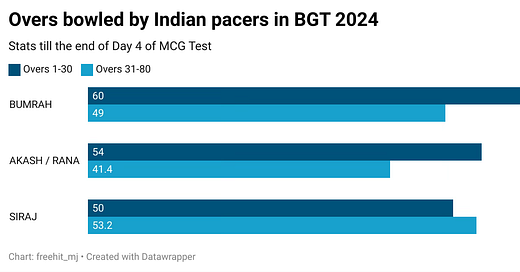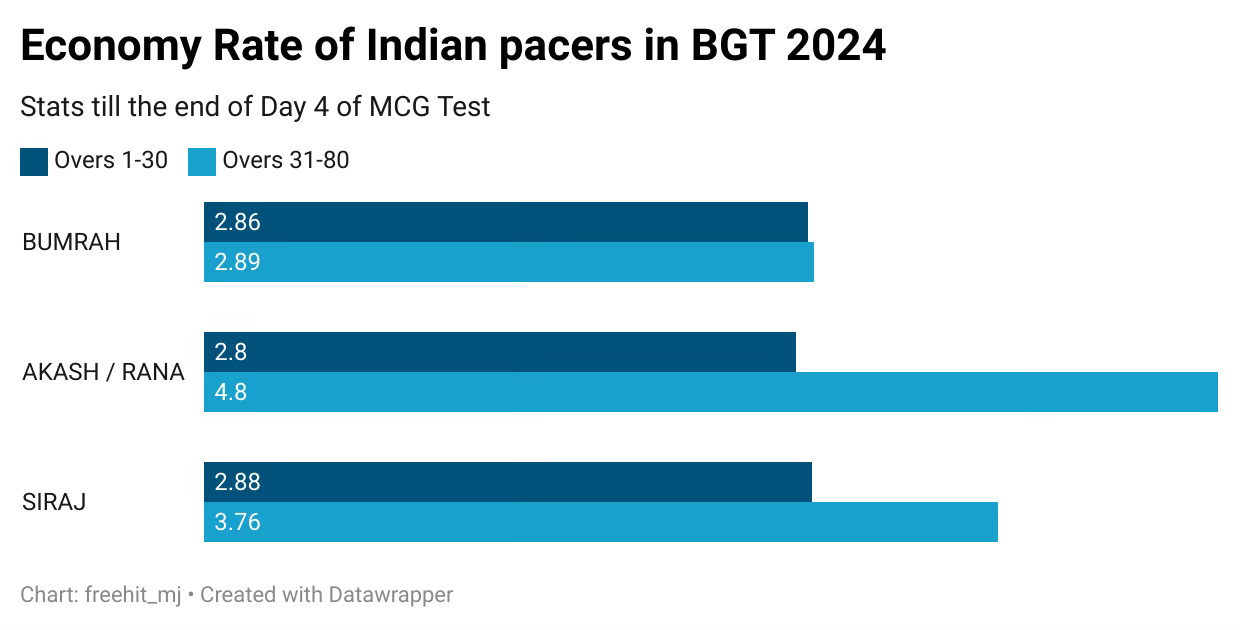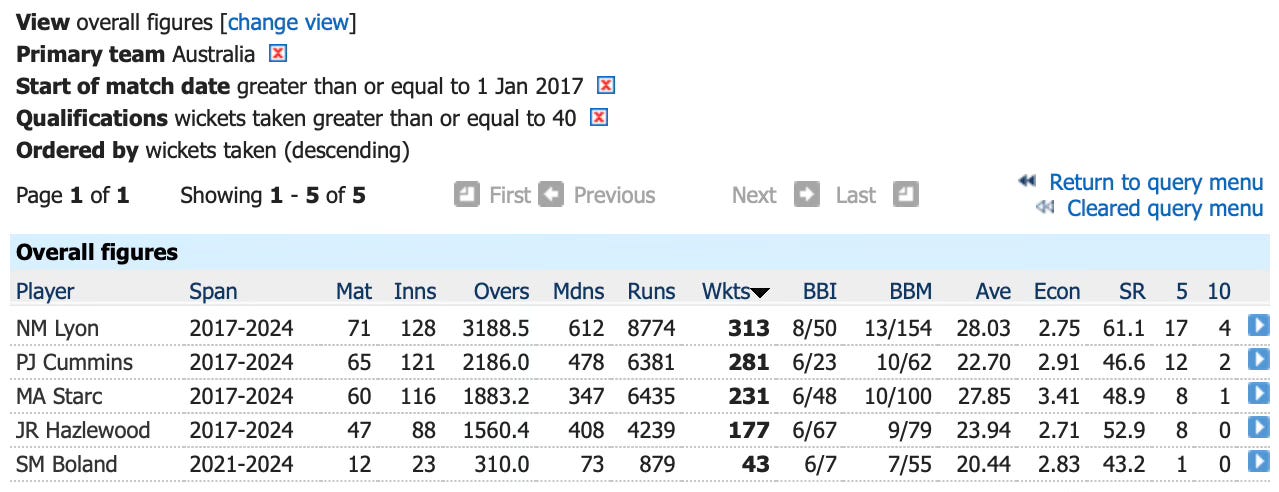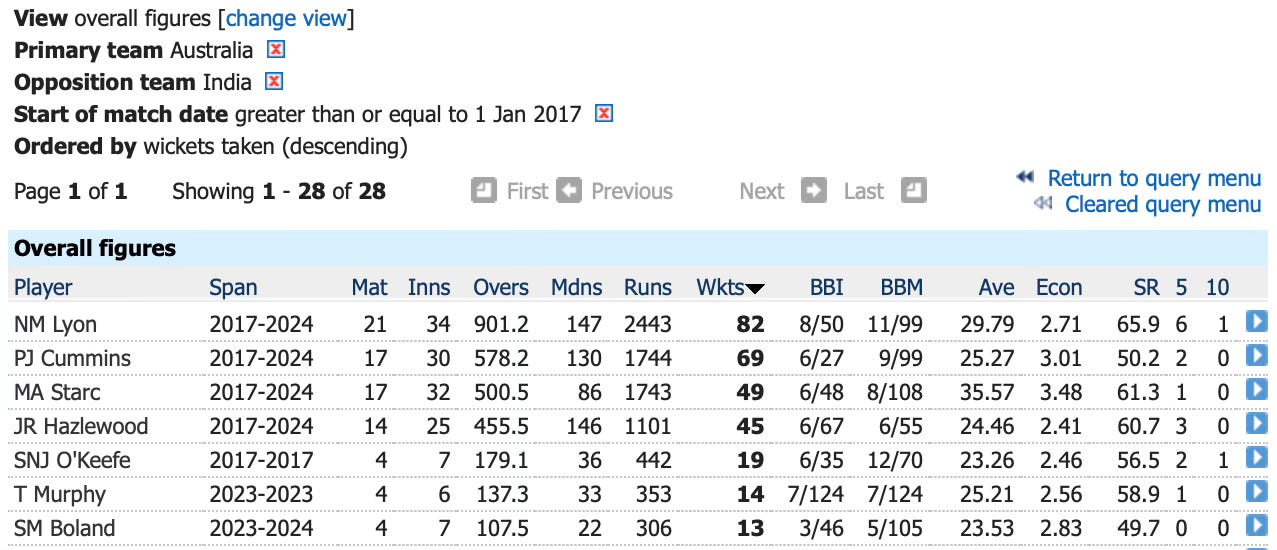Has the criticism of Mohammed Siraj been fair?
With the exception of his incredible spell in the 2nd innings at the MCG, the chatter around Siraj has generally been negative.
Across the 4 tests of the ongoing Border-Gavaskar Trophy, a lot of the focus from Indian fans has been on Bumrah and understandably so. India’s 2nd pacer Mohammed Siraj has quietly continued picking wickets at the other end, with 16 scalps to his name. Currently, he is the 3rd highest wicket taker in the series and yet large portions of Indian fans believe he’s been ordinary apart from a one-off spell.
Whether seeing reactions on Twitter or interacting with multiple groups of friends over iMessage or WhatsApp, the general sentiment around Siraj has been one of disappointment. To figure out if this is a fair criticism, I decided to take a closer look.
Workload of Indian pacers
Across all formats, Mohammed Siraj is pacer that India has trusted the most since 2022. In this period, he’s bowled 888 overs for India, just shy of Ravindra Jadeja’s 902 and Ashwin’s 932 since they typically bowl longer spells in Tests in India. Despite Bumrah’s large output in the ongoing series, India does well to rest him in many matches across formats, that’s why he’s bowled 120 overs fewer than Siraj. Due to a mix of injuries as well as rotations, no other Indian pacer has bowled even 450 overs in this time period. The Hyderabad-pacer has been India’s workhorse since his initial success on the last tour of Australia.
Coming back to this series, pacers across the sides have had a lot more to movement to extract in the first 30 overs of the innings. This is not an expected, since the Kookaburra ball goes soft after about 30-35 overs and bowling is substantially harder.
Here’s how India has spread the load across the 3 pacers picked:
Since Australia’s batted past the first 30 overs of the 2nd new ball just once, I have ignored those stats. All stats until the end of Day 4 of the ongoing MCG Test.
So in the overs where the ball does the least, the batters get a chance to settle and play their strokes, and India has put the ball in Siraj’s hand more than any other pacer. The only time Bumrah has bowled more overs with the older ball than Siraj was during the 1st innings of the Perth test, and even that was a shorter innings as the hosts were bundled out for 104. Siraj is consistently bowling the toughest overs, and maybe that’s the reason people think he’s not consistent enough or bowls plenty of loose balls.
Looking closer at the economy rates of Indian pacers in this series, it’s clear that Siraj has done a solid job when the ball is less than 30 overs old. Siraj has bowled the most maidens (40%) in the first 30 overs and also picked 6 wickets at a strike rate of 60. Bumrah’s clearly been the leader although his economy rate appears the similar to the others, thanks to a freak knock by Sam Konstas.
With the older ball though, he’s done much better than the 3rd pacer of the attack. Even when comparing Siraj with Akash Deep (who has much better control than Harshit Rana), the only innings where Akash Deep’s economy from overs 31-80 has been better than Siraj is 1st innings in Brisbane where Siraj leaked at over 4 runs an over. He was rightly criticized during that test although Bumrah clarified in the Press Conference that Siraj was bowling with a niggle.
As I have previously written on this blog, India’s selection of just 3 full-time pacers has been hurting the Indian team. While his returns in unhelpful conditions weren’t great, Siraj still continued bending his back for the team, and making sure Akash Deep and Bumrah can stay fresh for the new ball. So it’s perhaps, it’s not fair to criticize him on the basis of a couple of spells across 4 tests.
Role Definition
The other, more important, aspect to keep in mind is that not every bowler (or even player) can be asked to bowl in a specific fashion. Each bowler has their strengths and weaknesses. Take the Australian attack as an example, this is their record since Jan 2017:
Nathan Lyon’s record cannot be compared to the others since he is the only spinner, but take a look at Josh Hazlewood & Pat Cummins in comparison to Mitchell Starc. The two right-armers concede 23 runs for each wicket they take, and concede 2.83 runs an over. Mitchell Starc, on the other hand, goes at half a run more per over and concedes nearly 5 more runs per wicket.
In fact, if you look at Starc’s record versus India, it’s even worse. But Australia have continued to play to Starc even when Hazlewood is fit and someone as good as Boland is available. It’s because Starc is expected to play a different role - he’s the quickest pacer best known for pitching it up and getting wickets in a bundle, even if he occasionally goes for more runs. Starc also offers the additional variety of being the only left-arm pacer and that helps but in general, Australia trust him despite returns not being as tight as the others.
And that’s how India’s team management views Mohammed Siraj. Similar to Starc (or even Stuart Broad), Siraj isn’t the most consistent bowler but he can be lethal on his day. On a number of occasions, he produced magical spells like 6/15 in Cape Town to win India the 1st test of 2024, or the spells against Sri Lanka in ODIs in the World Cup & Asia Cup Final.
The ceiling of his performances is quite high and India’s captains are happy to trade a little bit of consistency for those splendid performances. They know that Akash Deep and the relentless Jasprit Bumrah can provide the consistency they need. And that’s he is giving the job of bowling the tough overs. It’s why he was preferred with the new ball in ODI World Cup in 2023 over Mohammed Shami.
All in all, while there are certain spells where he could have been tighter, Siraj’s monumental effort on this tour has ensured that Jasprit Bumrah can play all five tests. He’s a big reason why India are still in the series with a slim chance.







